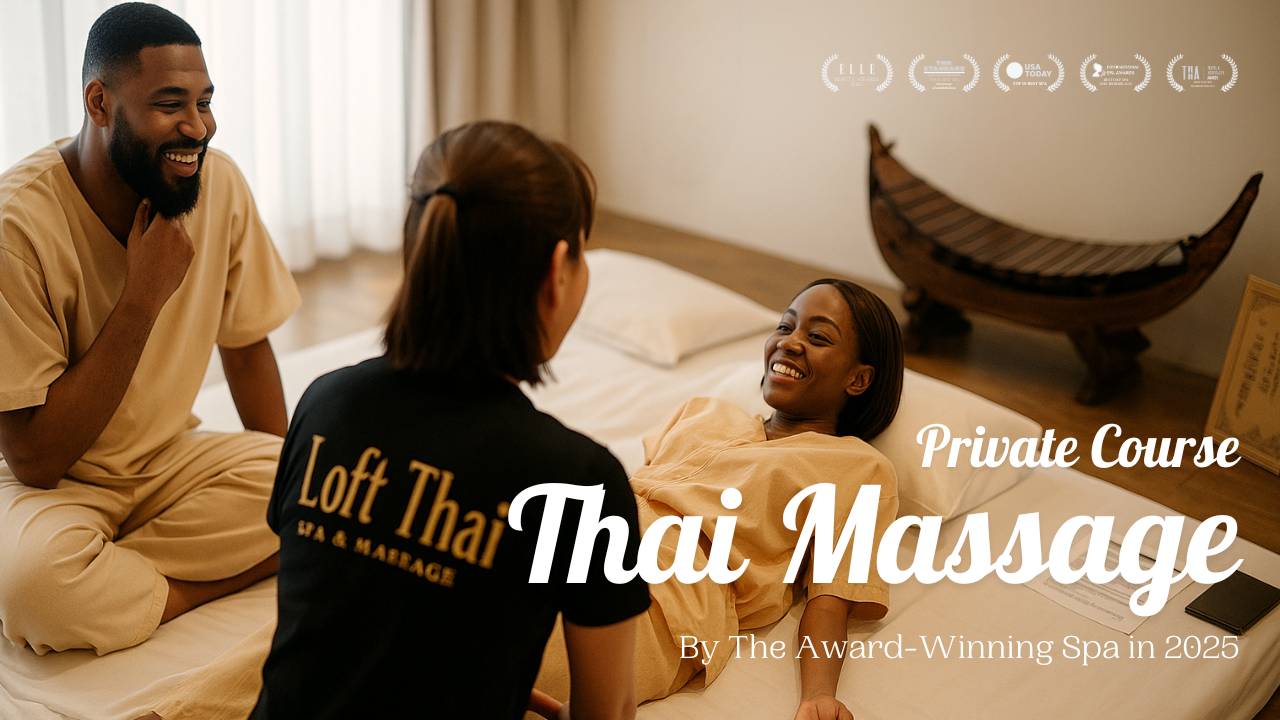Hidden behind the rhythmic tuk-tuk bustle and neon evenings of Bangkok lies a quieter, more ancient heartbeat—Thai massage, or Nuad Thai. Centuries before wellness became an Instagram hashtag, Thai healers were combining acupressure, assisted yoga stretches, and mindful breathing to restore balance in body and spirit. Today, UNESCO lists traditional Thai massage as an Intangible Cultural Heritage of Humanity, acknowledging both its medical value and its cultural depth.
How Easy Is It to Learn Thai Massage? A Beginner’s Guide
Our two-hour Thai Massage Workshop is designed to open that heritage to complete beginners and seasoned bodyworkers alike. Whether you are a couple seeking a shared skill, a yoga teacher adding hands-on assists, or a professional therapist who wants a fresh perspective, the program distils the essence of Nuad Thai into a structured yet fluid learning experience. You will leave not only with new manual techniques but also with a deeper understanding of Thai philosophy—rooted in compassion (metta) and mindful presence (sati).
Step-by-Step: What to Expect in a Thai Massage Course in Bangkok
The following article walks you through every minute of the workshop, expanding upon the timetable, contextualising each technique, answering common questions, and offering practical tips for those who wish to continue their practice at home. By the end, you will appreciate why a seemingly simple two-hour session can stand as the gateway to a lifetime of healing exploration.
1. Historical and Philosophical Foundations
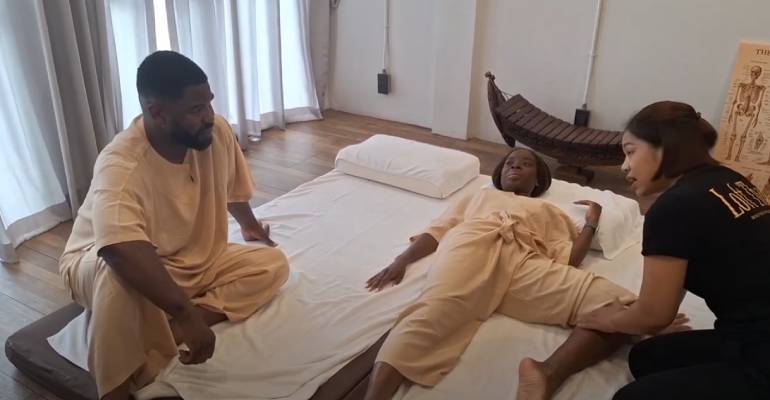
Traditional Thai massage traces its origins back more than 2,500 years to Jivaka Kumar Bhaccha—known in Thailand as Doctor Shivago—physician to the Buddha and friend of King Bimbisara of India. Over centuries, Indian Ayurvedic principles intermingled with Chinese acupressure theory and indigenous Thai healing rituals, evolving into the modality now taught in temples such as Wat Pho in Bangkok and practised globally.
At its core is the concept of Sen Sib, ten major energy pathways along which lom (vital wind or life-force) travels. Blockages along these lines can manifest as pain or dysfunction; therapeutic pressure, palming, and stretching aim to release the stagnation and restore flow. Unlike Western massage that primarily focuses on muscles, Nuad Thai works three interconnected dimensions: physical structure, bio-energetic flow, and the emotional–spiritual condition.
Equally important is the attitude of metta (loving-kindness). The practitioner approaches each touch as a humble act of service, synchronising his or her breath with the recipient’s. In the workshop, you will see how this intention transforms mechanical strokes into profound, empathetic communication.
2. Preparing for the Workshop
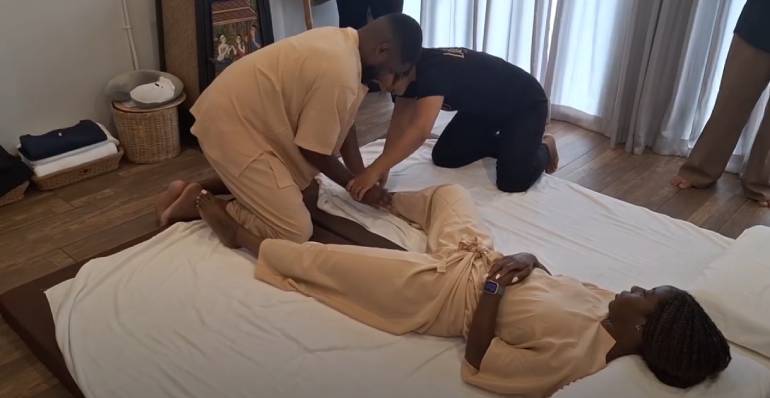
A good Thai massage session begins long before the first hand is placed on a client; it starts with thoughtful preparation.
Space. We arrange a dedicated practice room with padded floor mats to facilitate ground-based work—an integral feature of Nuad Thai. The temperature is kept comfortably cool, lights are dimmed, and a gentle aroma of lemongrass sets the olfactory scene. Soft Thai khim and ranat melodies play in the background to support a relaxed alpha-brain-wave state.
Mindset. Upon arrival, each participant is encouraged to let go of daily preoccupations. A short breathing exercise fosters internal quiet and present-moment awareness.
Hygiene and attire. Traditional massage uses no oils, so loose-fitting cotton clothing is ideal. Before the session, both giver and receiver perform a respectful water-based hand-washing ritual, symbolising a fresh start and preventing cross-contamination.
Tools. Unlike Swedish massage’s reliance on lotions and tables, Thai massage requires only the human body. However, pillows, bolsters, or yoga blocks can help modify stretches for participants with limited flexibility.
3. Minute-by-Minute Breakdown and Expanded Learning
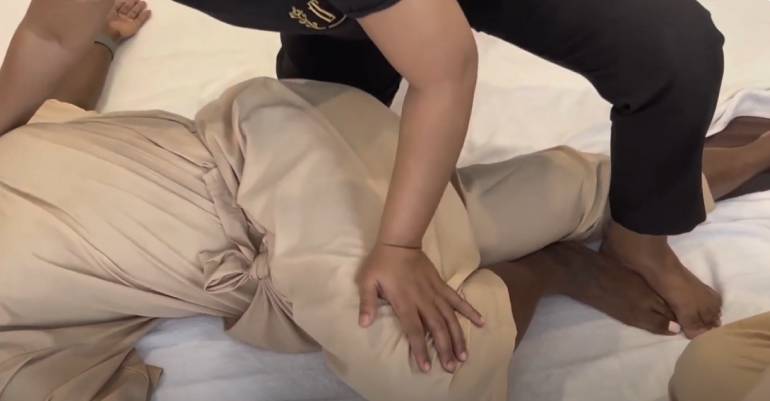
00:00 – 00:15 — Welcome & Introduction to Thai Massage
The instructor greets attendees in the customary Thai wai (palms together, slight bow), establishing a cultural bridge. A concise—but vivid—story of Nuad Thai’s evolution is narrated, highlighting how farmers relied on these techniques to overcome post-harvest fatigue and how monks preserved the lineage through temple murals and manuscripts.
Ice-breaking questions follow: “What’s your intention today?” or “Which body part always feels tight?” Sharing answers cultivates empathy among participants and helps the instructor tailor emphasis during practice. By demystifying both the art and the artist, this opening fosters psychological safety—essential for tactile learning.
00:15 – 00:30 — Basic Principles & Preparation
Body Mechanics
You learn that the best massage starts with your own posture. The instructor demonstrates kneeling, half-kneeling, and seated stances that keep the spine neutral and shoulders relaxed. Proper use of body weight—rather than isolated muscle strength—prevents practitioner fatigue and delivers steady, penetrating pressure.
Breath Synchronisation
A brief guided exercise encourages inhaling through the nose for four counts, holding for two, then exhaling for six. Matching your exhale with the pressing phase conditions a smoother rhythm and fosters parasympathetic engagement in the receiver.
Creating a Restorative Space at Home
Participants discuss household variables—floor surface, ambient noise, pets or children underfoot—and brainstorm solutions. A simple futon in a quiet corner, low lighting, and instrumental music can replicate professional ambience.
By the end of this segment, you understand that mastery of technique is inseparable from mastery of positioning, pacing, and presence.
00:30 – 00:45 — Foot Massage Techniques
Thai medicine considers the feet the energetic “roots” of the body, containing reflex points that correspond to organ systems.
- Warm-up Palming: You will cup the heel with one hand while the other hand’s palm circles arch to ball in a slow spiral.
- Thumb Walking: Starting at the lateral edge, thumbs alternate forward like caterpillars, following the transverse arch toward the medial side.
- Toe Pulls and Rotations: Gently grasp each digit, traction outward, then rotate clockwise three times, counter-clockwise thrice—aiding joint lubrication.
- Ankle Pump Stretch: With one hand stabilising the top of the foot, the other moves the foot into plantar and dorsiflexion, stimulating lymphatic return.
Ergonomic tips: Always angle the thumbs slightly, preventing hyperextension, and maintain wrists in a neutral line. Participants pair off, practising for five minutes each while the instructor circulates to refine thumb depth and wrist spacing.
Expected outcomes include lowered heart rate, a warm tingling through the calves, and an immediate sense of grounding—preparing both partners for deeper work ahead.
00:45 – 01:00 — Leg & Lower-Body Massage
Moving up the kinetic chain, the instructor demonstrates how to “sandwich” the calf between two forearms, rolling slowly from Achilles tendon to mid-knee. This broad surface area diffuses pressure, safe for beginners yet effective in loosening gastrocnemius tension.
Next, participants learn the classic “elephant walk” along the thigh: rhythmic alternating heel-of-hand presses on the quadriceps following the Sen Kalathari line. The back knee stays lifted, body weight driving pressure rather than arm force.
For hamstring release, the receiver bends the leg while the practitioner kneels at the side, positioning both thumbs on either side of the biceps femoris. Lean-in compression is held for three breaths, then slowly released—mimicking a muscle energy technique.
Circulatory benefits include boosted venous return and decreased postural edema, making this sequence valuable for office workers and long-haul travellers alike.
01:00 – 01:15 — Back & Shoulder Massage
As back pain is a global epidemic, this section often becomes the workshop’s highlight. Participants transition the receiver into a side-lying position, a posture that grants direct access to the paraspinals without requiring advanced flexibility.
Key manoeuvres:
- Forearm Glide: From sacrum to scapula, the practitioner uses the ulna edge, maintaining a continuous, unbroken flow.
- Scapular Scoop: Fingers nestle under the shoulder blade, gently mobilising stuck fascia.
- Neck Thumb Press: Working from the base of the skull down to C-7, thumbs apply steady vertical pressure alongside the lamina groove, steering clear of the spinous processes.
Proper alignment is again stressed—torso stacked over hips, core engaged, shoulders withdrawn from ears. The instructor also introduces a mantra of “soft eyes, soft heart,” a reminder to avoid tensing facial muscles while delivering care.
Many attendees report an audible sigh or emotional release at this point, a testament to the psychosomatic link between shoulder tension and stored stress.
01:15 – 01:30 — Arm & Hand Massage
Modern life inundates wrists with micro-movements—typing, swiping, holding steering wheels. Thai arm work offers elegant counterpoints.
The sequence starts with palming along the triceps line, then transitions into thumb circles around the elbow joint surfaces, encouraging synovial fluid distribution. Gentle traction of the radius and ulna follows, where participants learn a safe, subtle rotation to “decompress” forearm tissues.
For the hands, each metacarpal receives a rhythmical kneading. The instructor demonstrates how to use knuckles to trace the palmar grooves without overstimulating sensitive median-nerve areas. A concluding prayer-like palm press returns symmetrical energy to both partners, symbolising completion and gratitude.
01:30 – 01:45 — Head & Face Relaxation Techniques
With the receiver now supine, practitioners kneel behind the head. Light fingertip circles along the scalp’s temporal lines melt cranial fascia, while thumb pads stroke the brow from centre to temples—an anti-migraine move rooted in Ayurvedic marma therapy.
Special attention is paid to the masseter—often tight from unconscious jaw clenching. Using gentle knuckle rotations across the zygomatic arch, students learn to coax the muscle into letting go without direct intraoral work.
The section culminates in a short shared meditation. With palms cradling the crown, both partners synchronise their inhalations. This merging of breath often leaves receivers in a deeply restorative alpha-theta state, making the subsequent closing stretch feel like a gentle awakening.
01:45 – 02:00 — Wrap-Up, Q&A, and Certificate Presentation
The instructor guides a slow, full-body stretch: arms overhead while pointing toes, then curling knees to chest, integrating the session. Participants articulate what felt most impactful, reinforcing learning through verbal reflection.
Common questions addressed:
- “How much pressure is too much?”—Guidelines include monitoring receiver’s facial cues, verbal check-ins, and the “7/10 comfort rule.”
- “How often should I practise these techniques?”—For maintenance, once a week is ideal; for therapeutic goals, two to three short sessions may expedite recovery.
Finally, each student receives a souvenir certificate—a tangible reminder of their new skill—and a group photo commemorates the shared journey.
4. Extending the Practice Beyond the Classroom
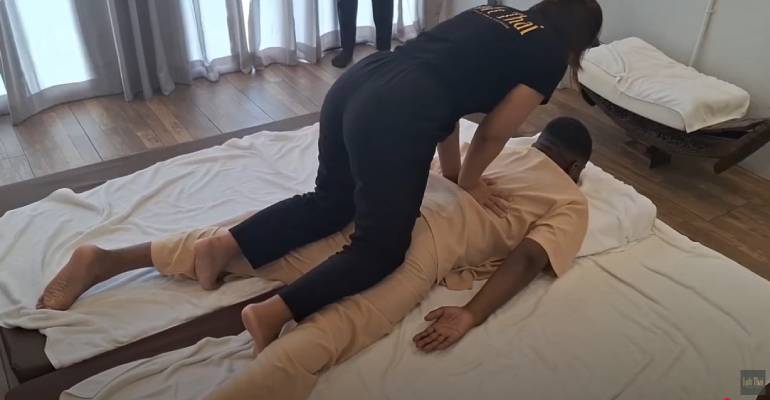
Creating a Home Routine
Start modestly: a 15-minute foot and leg sequence after work or a Sunday-morning head massage exchange. Consistency builds tactile intuition and helps normalise caring touch among friends or family.
Safety and Contraindications
Avoid direct pressure over acute injuries, varicose veins, or inflamed joints. Pregnant partners should receive modified side-lying work, avoiding deep abdominal lines. When in doubt, lighter pressure and broader surfaces (palms, forearms) are safer than thumbs or elbows.
Continuing Education Pathways
Nuad Thai is a lifelong study. Graduates often pursue:
- Level II Advanced Stretching Modules—introducing supine spinal twists and dancer-pose backbends.
- Tok Sen “Hammer Massage”—using wooden mallets to send vibrational energy along Sen lines.
- Therapeutic Thai Foot Reflexology—merging Thai, Chinese, and Japanese foot maps into a targeted session.
Each branch deepens anatomical knowledge and personal embodiment.
5. Participant Experiences
Emma, a London-based Pilates instructor, said: “I expected a quick tourist demo but left with biomechanics insights I now use in every class.” Chen, a software engineer from Singapore, added: “Learning how to press with my body weight instead of brute finger force changed everything; my girlfriend actually requests massages now instead of tolerating them.”
Such testimonials highlight the workshop’s dual success: imparting technical competence while nurturing relational connection.
6. Frequently Asked Questions

Do I need prior massage experience?
No. The curriculum is scaffolded so beginners can safely follow, while professionals can refine subtleties such as angle and pacing.
Will I learn the entire body routine?
Yes, but in an introductory format. Mastery of each technique requires practice; the workshop provides a fluent “alphabet,” and subsequent sessions help write “sentences” and “paragraphs.”
Is Thai massage painful?
Properly delivered, it should be an “intense comfort.” Any sharp pain signals the need to reduce pressure or adjust alignment. Communication is key.
What if I’m not flexible?
Most stretches can be modified with pillows or smaller ranges of motion; the goal is functional release, not forcing end-range poses.
Can I practise on elderly relatives?
Yes, with lighter pressure, slower transitions, and medical clearance if severe osteoporosis or cardiovascular issues exist.
Skill, Compassion, and Cultural Appreciation in Two Hours
In an age where wellness offerings often chase novelty—infra-red pods, cryotherapy, VR meditation—traditional Thai massage stands timeless, a testament to the power of grounded human touch. Our two-hour workshop distils millennia of wisdom into a coherent, accessible curriculum, blending historical context, anatomical precision, and the intangible richness of metta.
Participants emerge not only with new mechanical skills but also with sharpened interoception—the ability to sense subtle bodily cues in themselves and others. They learn that true healing arises from reciprocity: as the giver’s breath guides the press, the receiver’s muscles yield, and both journeys elevate.
If you are seeking a practice that nourishes your relationships, honours Southeast Asian cultural heritage, and equips you with a toolbox for lifelong wellness, this workshop offers the perfect initiation. The certificate you carry home is more than paper; it is a symbolic key. Behind the door it unlocks lies a path of service, mindfulness, and the profound joy of helping another human being meet their body with kindness.
We invite you to step onto the mat, breathe in unison, and let the art of Nuad Thai weave its gentle alchemy through your hands and heart.

